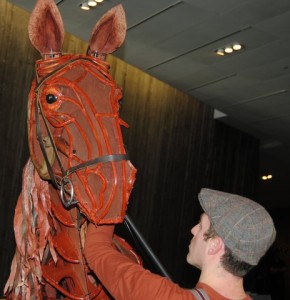War Horse: Technically Masterful but…
 War Horse
War Horse
Based on the novel by Michael Morpurgo. Adapted by Nick Stafford
Broadway Across Canada at the National Arts Centre
National Theatre of Great Britain production
The puppetry is brilliant. The staging is highly effective. The key performances are well executed. Yet, despite all this, it is difficult for anyone who knows the history of the horses used in the First World War to be wholeheartedly enthusiastic about the Tony award winning, War Horse by Michael Morpurgo, adapted by Nick Stafford.
As wrenching as Anna Sewell’s 1877 classic novel, Black Beauty, War Horse focuses on one horse. Joey, shown from colt through adulthood, is manipulated by three puppeteers — visible but soon unnoticed by audiences watching the story of his life unfold.
The heart of that story is the relationship between Joey and Albert (played with sensitivity and realism by Michael Wyatt Cox) the poor farmer’s son who owns him — until his drunken father betrays boy and horse by selling the animal to the war effort.
Determined to find Joey, Albert joins up, lying about his age as many youngsters anxious to serve their country did in 1914
The other human performance of note in the Broadway Across Canada touring production playing at the NAC until January 26 is by Maria Elena Ramirez as Albert’s mother, Rose. Pragmatic, straightforward and warm, she is equally believable in her love for her son and her frustration with her next-to-useless husband.
The remaining characters, with the exception of Captain Friedrich Muller — a strong characterization by Andrew May — are little more than sketched illustrations, a style followed through in the torn paper/pendant that crosses the set. Notes and images act as guides as Joey goes through the war years. The one moment of human contact that has a little more substance is an Irish and a German soldier joining together to rescue Joey when he is caught in a barbed wire fence.
Because the wonder of Joey and the other horse puppets and puppeteers are the true stars of the show, the poor enunciation of most of the remaining cast members — shouting does not compensate for lousy diction — does not detract too much from its technical artistry.
The images remain long after the unlikely but satisfying ending of War Horse. Sadly, so does the knowledge that most of the service animals who survived the horrors of war, disease and mistreatment were shot, rather than being shipped home when the “War to end all wars” ended.